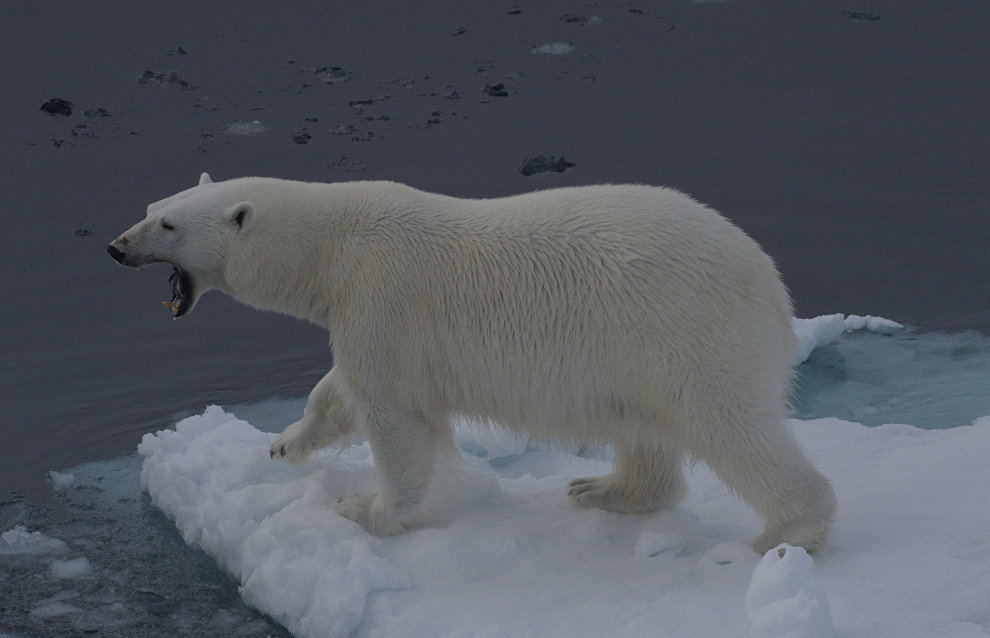Polar bears and walruses return to Pacific Arctic ice for the first time in 20 years
Scientists are observing an unusual cooling process in the Pacific Arctic against the backdrop of global warming. This natural phenomenon has allowed polar bears and walruses to resume their customary lifestyle on the ice and to stop wading ashore.
“First of all, we can talk about lower temperatures in Chukotka and Alaska because walruses have stopped showing up in coastal areas, where they lived over the past 20 years. No walruses were sighted this year < … > This is not abnormal, the situation is returning to normal. For the last 20 years, there was an abnormal warming process. Current sea-ice formations are not as thick as they were 40 years ago, but they are approaching these levels. I am delighted to say that the walruses and the bears have been given a respite,” said Anatoly Kochnev, PhD (Biology), a research associate with Beringia National Park and an expert on marine mammals.
According to the scientist, ice/ice-floes remained in coastal waters all summer long, and walruses that have been setting up huge coastal breeding grounds for the past few years stayed on these ice formations.
“They are adapted to this, and they need ice-floes. Earlier, there were no walruses on the shore in these coastal areas, and the bears seldom ventured there because they were quite happy staying on ice-floes. They began to wade ashore only when sea-ice formations melted away because they needed a place to relax. Walruses choose capes protected from the winds, while staying ashore. They drift on ice-floes, and they don’t have to waste energy on moving around: They can dive from ice-floes, eat something on the seabed, return to the ice-floes and sleep to their heart’s content. Their ice-floes will drift to other areas while they are asleep, and the walruses will dive again in the new location,” the specialist said.
Kochnev noted that, over the past 20 years, the walruses had faced a difficult situation when ice-floes formed later than usual. They had to swim for hundreds of kilometers from coastal breeding grounds in order to find food. There are few areas with large concentrations of mollusks and worms, the mainstay of the walruses’ diet. Walruses have to spend a lot of their energy on making these two-way trips, that is, from breeding grounds to feeding areas and back.
“Although they ate a lot, they grew thinner and thinner because they spent more energy. There were many thin and emaciated animals, and their mortality rates also soared. They are now staying on ice-floes, and life is fantastic. The bears are also leaving for the ice-floes. The problem is that they are unable to hunt seals when there are no ice-floes. They like seals better than walruses because the seals are tastier and fatter, and because it is easier to hunt them. Unlike walruses, seals have no tusks for hitting back,” the scientist noted.
In the past few years, dwindling sea-ice formations have forced the walruses to wade ashore en masse, and the polar bears have also followed suit. The situation compelled these predators to start feeding on walruses. Polar bears used to hunt walruses in the past but only rarely. Now, they started attacking walruses on a regular basis, due to the warming process and dwindling ice-floes, he explained.
“Now that sea-ice formations have appeared, they no longer have to take their chances and attack walruses. They can feed calmly on seals. This year, polar bears who used to wade ashore near Cape Schmidt all the time (in previous years) stayed on ice-floes and went ashore only during storms that broke their ice-floes apart. The sea calmed down a day or two later, ice-floes formed once again, and the bears returned there again. There were many seals on the ice,” the scientist noted.
He added that, in 2021, ice-floes had carried polar bears further east, than usual, to areas where they were rarely seen before. The scientist believes that the 2021 cooling trend on the Chukotka coast is temporary, and that the overall warming trend will resume.
“It will be great if this trend dies out. Earlier, we were worried about the bears and the walruses because dwindling sea-ice formations impact their populations and threaten the animals’ existence. However, sea-ice formations would expand in the event of a sustained cooling trend, and there will be no threat to the animals. In such a case, we would have to change our research priorities and see how the warmer years had affected the animals, and whether they are using their newly-acquired skills,” Kochnev said.
According to the scientist, research methods will change because it will be more difficult to watch the animals among the ice-floes. Specialists will have to use remote tracking methods and to deploy icebreakers.
“But we will no longer be concerned about the animals’ future, although we need five to ten years to establish whether this cooling trend is sustainable, rather than temporary,” the biologist said in conclusion.
